Parks Group Applauds “Status Quo” Budget
Ann Arbor park advisory commission meeting (April 16, 2013): After several years of cuts, the city’s parks system anticipates no significant budget changes in fiscal year 2014, which begins July 1, 2013.
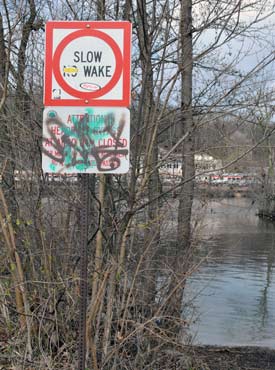
Graffiti at Argo Pond. Parks and recreation manager Colin Smith reported that there’s been an increase in graffiti in the parks system. (Photos by the writer.)
Park commissioners were briefed on budget details at their April meeting, and voted unanimously to recommend the budget for approval. The parks budget will be a component of the overall budget that the city council will vote on in mid-May. The public hearing on that budget will be held on May 6. “The message is status quo,” parks and recreation manager Colin Smith told commissioners.
In a separate vote, commissioners recommended raising fees – ranging between 4-9% – for rentals at the Gallup Park meeting room and Cobblestone Farm. It was the first fee increase at these facilities since 2007 and 2006, respectively.
In other action, commissioners unanimously recommended approval of a five-year contract with Coca-Cola Refreshments for cold beverage concessions. It will replace the 10-year contract with Pepsi that expires this summer. Pepsi was the only other bid received by the city for a new contract, but missed the deadline and was disqualified.
Commissioners also recommended that the city award a $535,000 contract to Pranam Global Tech Inc. to replace the nearly 40-year-old roof at Veterans Memorial Park Ice Arena. The project includes a 10% construction contingency of $53,500, bringing the total project budget to $588,500.
Public commentary included an update from advocates of an ice-skating rink at the city-owned Library Lane site, as well as a report from the Library Green Conservancy, which hopes to make the parking lot into a park. [.pdf of Library Green Conservancy report]
Updates from commissioners included ongoing efforts to find a new centrally located dog park, as well as more information-gathering work by the downtown parks subcommittee.
And in his manager’s report, Smith informed commissioners of an increase in spray-painted graffiti in the parks. The staff is collecting data on how much time they spend repairing areas that are hit with graffiti, “and it’s substantial,” he said. Even trees have been tagged, which is unusual, Smith reported. “There have been some rather inappropriate things painted on some very nice trees.” He added: “It’s extremely frustrating … We’re not in the business of providing spray-painting opportunities any more than we are in the business of providing apothecary options for people in the parks. I’ll leave it at that.”
Parks and Recreation Budget
One component of the city’s fiscal year 2014 budget – for the parks and recreation unit – was on PAC’s April 16 agenda for review. [link to the city's Legistar system, where 12 parks-related budget documents can be downloaded] FY 2014 begins on July 1, 2013.
Colin Smith, the city’s parks and recreation manager, gave a presentation with highlights of the budget. [.pdf of budget presentation] He began by noting this is the first budget in at least a decade that hasn’t included service reductions. “So it’s a little bit of an easier message,” he said. Smith also thanked commissioners Tim Doyle and Bob Galardi for reviewing the budget in more detail, as members of PAC’s budget & finance committee.
He explained that this is the first year of a two-year budget plan. Ideally, he said, the second year is less labor-intensive to prepare, and usually requires only minor modifications. He noted that the city council has already been briefed on this budget proposal for parks and recreation at a working session earlier this year. There were very few questions from councilmembers, he said, “which is a little bit different than it’s been in the past, and I hope is reflective of the fact that there are not any significant changes in this particular budget.”
Organizationally, parks and recreation operations are part of two different city units, Smith explained. Most of the parks and recreation services fall under the city’s community services area, led by Suhmed Bahl. Those operations include recreation facilities and administration, the farmers market, the natural area preservation program, capital projects, park planning, and volunteerism. Park maintenance and park forestry are part of the city’s public services area, overseen by Craig Hupy.
Smith also explained the two primary funding sources for parks and recreation. The city’s general fund supports a range of activities, including mowing, snow removal, utilities, and the daily operations of most recreational facilities and administration.
The second source is the city’s parks maintenance and capital improvements millage, which pays for capital projects and park planning, parks forestry, park maintenance, the natural area preservation program (NAP) and volunteerism.
Budgeted expenditures for the parks and recreation unit in FY 2014 – from the city’s general fund as well as from the parks maintenance and capital improvements millage – are $12,546,068. Of that, about $5.2 million will be paid from the millage, with $7.3 million from the general fund. In addition, the parks and recreation unit has responsibility for several smaller budgets, including a separate fund for the farmers market.
“The message is status quo,” Smith told commissioners. “There’s not a significant change here.”
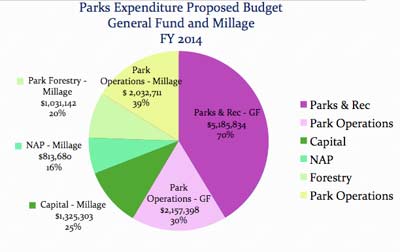
FY 2014 Ann Arbor parks and recreation budget chart (from PAC slide presentation). The percentages do not refer to the overall pie chart, but rather to the percentage from the general fund or millage, respectively.
Smith noted that the parks system generates “a not insignificant amount of revenue” for the general fund – about $3.8 million. Expenses are higher than that, however, so the system gets additional support from the city’s general fund, too.
Among the items Smith noted in his presentation was a change in the budgeting for the city’s two golf courses at Huron Hills and Leslie Park. [PAC received a more detailed update on golf operations at its March 19, 2013 meeting.] Rather than operating as a separate golf enterprise fund, as it has in recent years, the budget for the golf courses will be part of the parks and recreation portion of the general fund. That change better mirrors how the golf courses actually operate, Smith said, and helps integrate the golf operations into the rest of the parks and recreation unit. Responding to a query from Christopher Taylor, Smith reported that the projected loss from the combined golf courses is $173,000 in FY 2014 and $133,000 in FY 2015. He described it as “middle of the pack” in terms of support required for the city’s other recreational facilities.
Smith also stressed that moving the golf operations into the general fund would not “cannibalize” other operations or facilities.
Highlighting other areas, Smith noted that the FY 2014 budget is projecting a $58,000 increase in revenues from the Cobblestone Farm facility, related to increased rentals as well as the proposed fee increases. Revenue increases are also projected for the Argo and Gallup canoe liveries – up by $106,000 – because of increased rental activity. He reminded commissioners of the presentation made at PAC’s March 19, 2013 meeting by Cheryl Saam, facility supervisor for the Argo and Gallup canoe liveries. Since the Argo Cascades opened, the liveries have increased rentals from about 35,000 people per year to nearly 50,000.
The ice arena at Veterans Memorial Park is projected to have $23,000 less in revenues for FY 2014. That figure primarily reflects fewer registrations for ice-skating lessons. Smith said it was a small decrease in the context of the roughly $475,000 in revenues that the arena brings in each year.
The farmers market, which operates as an enterprise fund, has budgeted for an increase in expenses for FY 2014 to reflect operational needs, Smith said. Three years ago, he noted, the market recorded about 1,000 transactions for Bridge Cards, which act like debit cards and have replaced food stamps, as well as for the “Double Up Food Bucks” program. In the past year, the market recorded about 6,000 transactions, or about $100,000 in revenue. To handle this increase, the market needs more staff during market hours, he said.
At the same time, the market has seen a decrease in annual parking revenue from about $30,000 to $10,000. That decrease is tied to changes in the 2011 parking contract negotiated between the city and the Ann Arbor Downtown Development Authority, which manages the city’s public parking system. As part of the transition, the parks system received a one-time lump sum payment of about $100,000, Smith reported. Of that, about $70,000 was put into the market’s fund balance. Some of that fund balance will now be used in FY 2014 and FY 2015 to cover the market’s gap between expenses and revenues.
The city’s market manager, Sarah DeWitt, is already working on ways to align expenses and revenues in the future, Smith said. She’s developing recommendations with the public market advisory commission, he added, and those recommendations would then be reviewed by PAC.
PAC’s April 16 budget resolution highlighted several key elements of the fiscal 2014 parks and recreation budget:
- Increased revenue due to higher than anticipated usage at the Argo Cascades.
- Increased revenue by increasing rental fees at Cobblestone Farm and the Gallup Park meeting room.
- A continuation of the 14-day mowing cycle.
- Continued use of seasonal park supervisor positions to increase staff presence in the parks for improved maintenance and enforcement.
- A reduction in natural gas usage expenses, reflecting recent infrastructure energy improvements at various recreational facilities.
- A reduction in expenses for materials and supplies that were previously needed to maintain recreation facilities, as a result of recent improvements.
- A plan to optimize staff software use and eliminate unnecessary software installations where appropriate.
Parks and Recreation Budget: Commission Discussion
Alan Jackson noted that parks maintenance expenses have dropped because personnel costs are down. He referred to survey results that had been included as part of the most recent parks and recreation open space (PROS) plan, which indicated that some residents weren’t happy with the level of parks maintenance. He wondered if an increase in volunteerism has helped reduce maintenance costs.
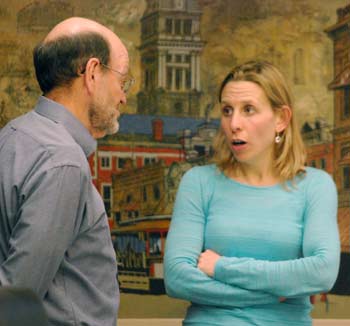
Ann Arbor park advisory commissioners Tim Doyle and Julie Grand. Doyle has chaired PAC’s budget & finance committee. His term ends on May 17 and he will not seek reappointment.
Smith replied that when the survey was done a few years ago, the city was at a “low point” in terms of its budget, and the parks system was on a 21-day mowing cycle, compared to the typical 14-day cycle. “So that entire summer, grass was far longer than what people were used to and far longer than people cared for it to be,” he said. That dissatisfaction was reflected in the survey results, Smith added. The city has now returned to a 14-day cycle, so he thought those concerns had been addressed.
Regarding volunteerism, Smith said that in general it’s a way to improve or enhance the work of staff, not necessarily to alleviate that work. It’s also a way to engage people in the community to take ownership of their parks, he added, “but I wouldn’t identify it as a cost-saving measure.” There’s also a lot of staff time needed to run a volunteer program well, he said.
Christopher Taylor noted that it was delightful not to have service cuts in this budget cycle. “It seems like it’s been a long time, so huzzah to us all.” He noted that in the past, PAC has received a spreadsheet that provided data on per-user subsidies to the various parks and recreation facilities, along with historical data for those subsidies. It would be useful to see that information, Taylor said.
Tim Doyle thanked Smith and field operations manager Matt Warba, saying that the budget & finance committee had spent close to five hours with them reviewing the budget. More detailed financial data is available, he noted, but “it requires green eyeshades and a lot of intense effort” to digest. Doyle said he pushed hard not to include the level of detail that’s provided in PAC’s meeting packet. He preferred a less detailed briefing, but other commissioners should let Smith know how much information they’d like in the future. Doyle applauded Smith for being knowledgeable, transparent and open with PAC about these budget details.
Julie Grand noted that if Smith had stood here five years ago and said that golf operations would no longer be an enterprise fund, “we would have had people lined up down the hall and out the door because of the fear that it meant golf would go away.” It’s a credit to staff to be able to go through this transition smoothly, she said.
Grand also reported that earlier in the day, Doyle had informed her that he would not be seeking reappointment for a second term. He’s planning to spend more time in Florida. It’s sad for everyone, she said, adding that PAC was grateful that he had chaired the budget & finance committee. She said she was glad he didn’t leave mid-budget cycle. Doyle’s term ends on May 17.
Smith joked that he’d be happy to come to Florida to discuss the budget with Doyle next year.
Outcome: Commissioners unanimously recommended approval of the FY 2014 parks and recreation budget. The PAC recommendation will be forwarded to the city council, which is expected to vote on the city’s overall budget on May 20. A public hearing on the city’s budget will take place at the council’s May 6 meeting.
Fees for Cobblestone, Gallup
Commissioners were asked to recommend fee increases – ranging between 4-9% – for rentals at the Gallup Park meeting room and Cobblestone Farm. The fee increases would take effect during fiscal year 2014, which begins July 1, 2013. [.pdf of fee schedules] [.pdf of comparative fee data]
Fees haven’t been increased at Gallup Park meeting room since 2007, and the facility is undergoing major renovations this summer that were approved by the city council on April 1, 2013. As an example of the fee increases that would take effect in January of 2014, a resident of Ann Arbor could rent the meeting room for 2-10 hours at $40/hour – up from the current rate of $25/hour for 2-4 hours and $30/hour for 5-10 hours.
Jeff Straw, deputy manager of parks and recreation, told commissioners the new fees reflect the upcoming renovations, as well as comparable fees at other city-owned facilities and at similar facilities in the community.
For Cobblestone, rental fees – which were last increased in 2006 – would increase by 4%. The base rental time would also increase from 10 to 15 hours. For example, a resident of Ann Arbor who rented Cobblestone for a Saturday event during the months of May through September would pay $1,560 compared to the previous fee of $1,200. The new rates would take effect in July of 2013.
Cobblestone can be rented for larger groups, up to 150 or 200 people, and is a popular place for weddings. Straw noted that in the past, the city would charge an hourly rate if an event lasted longer than 10 hours. But more events in recent years are taking longer than 10 hours, so the staff is proposing to increase the base rental time. Straw said this would prevent customers from being “nickel and dimed,” and also give them more time so they don’t feel rushed.
Cobblestone is generally booked every Friday, Saturday and Sunday from April through November, and the facility is booked 18 months in advance. There’s high demand, and that was another factor in setting the new fees, Straw said.
Colin Smith, the city’s parks and recreation manager, noted that as part of the budget process, the staff reviews fees at all of its facilities. In that context, this year there are very few increases being proposed. It’s somewhat of an art, he added, because you don’t want an increase to result in lower demand.
Fees for Cobblestone, Gallup: Commission Discussion
Alan Jackson wondered if the use of Gallup’s meeting room was high. It is, Straw replied, and it’s expected to be booked even more after the renovations. There will be French doors that open onto a patio overlooking the Huron River, making it more attractive for wedding receptions and other events, he said. Parks and recreation also uses the room for the city’s summer day camp.
Tim Berla wondered if the staff had considered trying to book two events in one day, on Fridays and Saturdays. Would that be a plausible way to bring in more revenue?
Straw replied that the majority of people are looking to use the space for a longer period. The staff would be open to that, but he didn’t think the logistics would work in most cases. “We’d certainly try to make it work if we could.”
Missy Stults noted that because the hours are increased at Cobblestone, the fees on an hourly basis aren’t actually increasing very much. She asked if the staff felt comfortable that these new fees would increase revenues. Yes, Straw replied. The staff believes these fees will cover the operational costs as well as make the facility more competitive.
Ingrid Ault wondered why the city hasn’t raised fees for so many years. The staff had evaluated a possible increase in the past, Straw said, as part of each two-year budget cycle. But until now they didn’t feel it was the right time to raise fees, given economic conditions.
Smith added that the overall economic climate is always a consideration. He also noted that in the past few years, the staff at Cobblestone have gotten more involved in helping people create and plan their events. So events have become more elaborate and take more time, and the fee increase reflects these operational changes, too, he said.
Smith also pointed out the distinction between the city and a business, which might raise its rates annually to cover higher costs. In contrast, if the city did that, it would be less “palatable” from a customer service standpoint, he said. “It is tricky.”
Ault asked whether the Tuesday evening farmers market at Cobblestone pays a fee. Yes, Straw said. They’re charged a park use fee, similar to what any group would pay to rent a field in a park or baseball diamond.
Julie Grand wrapped up the discussion by saying she was thrilled that these are the only fees the city is raising. This is the first year in a long time that there haven’t been cuts to the parks and recreation budget, she noted. “It’s refreshing that we don’t have to think about revenues on the other side.”
Outcome: PAC unanimously voted to recommend approval of the fee increases. These recommendations will be forwarded to city council for its consideration.
Coke Contract
Commissioners were asked to recommend approval of a five-year contract with Coca-Cola Refreshments for cold beverage concessions.
A 10-year contract with Pepsi Bottling Group of Michigan is set to expire in mid-June of 2013. In vying for the new contract, only two companies responded to a request for proposals (RFP). According to a staff memo, the other bidder was disqualified after failing to meet the bid deadline. The memo did not name that company, but deputy parks and recreation manager Jeff Straw told commissioners that Pepsi had missed the deadline.
The new contract will cost the city an estimated $25,000 annually for non-vending items, but the city expects to generate $47,500 in revenues from the beverage sales. In addition, Coca-Cola Refreshments will provide an annual sponsorship fee of $10,000 to the parks and recreation unit, and give a 96-cents-per-case rebate on each case that’s sold. These funds will be used to provide scholarships to low-income kids for parks and recreation programs. The case rebate is estimated to bring in $700 to $1,000 each year for scholarships, according to Straw, depending on sales.
The company also will provide 50 cases of free product each year for public special events, and will sponsor four special events annually with product sampling and free giveaways. The firm also will provide recycling containers with credit for returnables.
Concessions and vending are located at Leslie Park Golf Course, Huron Hills Golf Course, Veterans Memorial Park, Buhr Park Pool and Ice Rink, Fuller Park Pool, Mack Indoor Pool, Gallup Park Canoe Livery and Argo Canoe Livery.
Coke Contract: Commission Discussion
Alan Jackson indicated that it was somewhat difficult to evaluate, because there’s only one bid – so he asked Straw to comment on how the proposed contract compares to the current one. He also asked if the city would need to purchase new equipment related to this change in vendors.

From left: Field operations manager Matt Warba and Jeff Straw, deputy manager of parks and recreation.
Straw said the city had expected to get bids from both Pepsi and Coke. He agreed it was difficult, given that one of those companies didn’t meet the deadline. However, the new contract is competitive, he said – based on comparison to the existing contract as well as checking with other entities that use a beverage vendor.
Regarding the equipment, Coke will be providing the equipment at no charge, Straw said, as well as replacing anything that breaks during the contract period.
Ingrid Ault wondered if it would be possible to get a contract with Faygo, to promote Michigan-based companies. Straw replied that if Faygo had bid on it, the city would have considered it. Ault clarified with Straw that the next opportunity would be in five years, when the contract is put out for bid again. She suggested reaching out to Faygo at that time, to make sure the company knows about it. Colin Smith, the city’s parks and recreation manager, noted that these bids are posted online as part of a statewide network [the Michigan Inter-governmental Trade Network (MITN) Purchasing Group]. He indicated that it’s possible Faygo saw the city’s posting but decided not to bid.
Missy Stults asked if there was a plan for the existing equipment. Straw said Coke will work with Pepsi on a transition plan so there’s no interruption of service. The old equipment would go back to Pepsi.
Smith pointed out that Coke and Pepsi both offer a lot of products other than soda, including bottled water and juice.
Outcome: Commissioners unanimously recommended approval of the contract with Coke. The recommendation will be forwarded to the city council for consideration.
Vets Ice Arena Roof
On PAC’s April16 agenda was a resolution recommending that the city award a $535,000 contract to Pranam Global Tech Inc. to replace the roof at Veterans Memorial Park Ice Arena. The project includes a 10% construction contingency of $53,500, bringing the total project budget to $588,500.
Pranam, based in Livonia, was the lowest of five responsible bids received by the city. Other bidders were A.Z. Shmina Inc. ($612,000), Cedroni Associates Inc. ($738,000), Construction Solutions Inc. ($738,800) and Phoenix Contractors ($747,754).
Parks and recreation manager Colin Smith introduced the item, noting that the roof is nearly 40 years old and has several leaks. A coating was applied 12 years ago but is no longer effective. The purlins and beams have rusted due to moisture condensation, and many need to be replaced and painted.
Amy Kuras, the city’s park planner, reported that in the past few years the roof has leaked so badly that Dennis Simon, the facility’s supervisor, has had to put out 20-30 cones on the ice to warn people who were skating. The city hired Stantec, a structural engineering firm, to evaluate the structural integrity of the roof and supporting structure. Those consultants gave the city several options, Kuras said. The option that’s being pursued is to leave the existing roof in place and put another steel roof on top of it, which will also increase the amount of insulation. That should help keep the ice arena colder, Kuras said.
The city solved the issues it was having with condensation by installing a dehumidification system several years ago, Kuras said, but the purlins and beams were already damaged by then.
There’s also a solar system on the roof, so as part of this project the city will test the system to see how well it’s functioning. If it’s still functioning well, the system will be reinstalled – but in a way that won’t pierce the roof. Kuras indicated that installing the solar system had contributed to the roof leaks.
The work will take place over the summer. Kuras noted that because the existing roof won’t be removed, there’s no reason why the facility won’t be able to open on time in the fall.
The project will be funded from the FY 2013 park maintenance and capital improvements millage proceeds.
Vets Ice Arena Roof: Commission Discussion
Christopher Taylor wondered how much height would be added by the new roof. Kuras replied that there’ll be about six inches between the old and new roofs, so overall she estimated it might add a foot to the structure. The insulation will be in the new roof, not in a separate layer between the two roofs.
Regarding the selection of the lowest responsible bid, Ingrid Ault asked how the staff determines what “responsible” is. Kuras explained that it includes whether all the requirements of the bid have been supplied, and whether the city has experienced poor performance from the bidder in the past. Pre-qualifications were also a factor in this particular bid, she said. Kuras said it’s pretty rare for the lowest bid to be rejected. The bid includes examples of other projects as well as references.
Alan Jackson asked if there was any difference in the types of roofs that different bidders offered, in terms of things like durability. Kuras replied that the city specified the type of roof system. The bidders were permitted to submit an alternative, but what the city wanted was a contractor to purchase and install the specified roof system, which had been suggested by the engineering consultant Stantec. “We rely on their expertise,” Kuras said.
Parks and recreation manager Colin Smith noted that Suhmed Bahl – Smith’s supervisor, who serves as the city’s community services area administrator – has a background in engineering. “I think he occasionally quite likes when these things come up to weigh in,” Smith said.
Jackson noted that as someone who plays ice hockey, “I have certainly witnessed directly the deterioration on the ice surfaces” as well as the rusted roof.
Jackson wondered if the existing roof contains asbestos. It’s metal, Kuras said, so there’s no asbestos, but there might be lead paint. That will be tested, she said, and if lead paint is found, it will be abated. An allowance for that is already built into the contract.
Julie Grand asked how long the new roof is expected to last. Kuras indicated that it would be a standard warranty of 20 years, but she expected it would last much longer than that.
Taylor wondered how the staff would know if the top roof developed leaks, given that the water could get trapped by the original roof. Kuras said it would be the same situation as the one that currently exists. It’s difficult to tell where the actual leak is on the top of the roof, because there’s insulation between the ceiling and the rooftop. “It’s much more difficult than a standard shingle roof,” she said.
Outcome: Commissioners unanimously voted to recommend awarding the contract to Pranam Global Tech. PAC’s recommendation will be forwarded to the city council for consideration.
Communications & Commentary
There were several opportunities for communications from staff or commissioners during the April 16 meeting, as well as time for public commentary.
Communications & Commentary: Manager’s Report
Colin Smith, parks and recreation manager, reported that the weather this spring “hasn’t been anybody’s friend.” Bad weather has caused some of the park system’s construction projects to limp along, he said, and it’s been the latest opening for the golf courses in more than 20 years. He reported that the city has completed the majority of seasonal hiring for its recreation facilities, including pools and canoe liveries.
Smith also reported that there’s been an increase in spray-painted graffiti in the parks. He asked commissioners to let him know if they see any graffiti in the parks that they visit. The staff is collecting data on how much time they spend repairing areas that are hit with graffiti, “and it’s substantial,” he said. Trees are being tagged, which is unusual, Smith reported. “There have been some rather inappropriate things painted on some very nice trees.” He hopes to figure out how to reduce it or to make sure that the people who do it are made responsible for restitution. Every hour that the staff spends dealing with graffiti is an hour that they could spend doing something else, he noted. “It’s extremely frustrating … We’re not in the business of providing spray-painting opportunities any more than we are in the business of providing apothecary options for people in the parks. I’ll leave it at that.”
Communications & Commentary: Downtown Parks
Tim Berla asked for an update on the downtown parks subcommittee, hoping that PAC will have recommendations “before the council sells anything.” Christopher Taylor, an ex-officio member of PAC who also serves on the city council, indicated that there would be sufficient time before the council acted. [Berla was referring to steps that the council is taking possibly to sell the former YMCA lot, which the city now owns, at Fifth and William.]
Ingrid Ault, who chairs that subcommittee, said the group has put together a strategic plan for its work and is doing data collection and research through late May or early June. They’ll do community outreach in June, and plan to report recommendations to city council in late July or early August. She expected that the subcommittee’s April 23 meeting would include presentations from local groups that are interested in this topic. [The subcommittee's next meeting is on Tuesday, May 7 from 5-6 p.m. at the second floor council workroom in city hall, 301 E. Huron.]
Communications & Commentary: Dog Park
Berla also requested an update on the selection of a new dog park. He felt that there are two really committed groups of citizens “with very opposite opinions” about choosing a location at West Park for that purpose. Noting that the staff and dog park subcommittee had evaluated about 15 possible locations, Berla hoped they would be able to look at a much larger number of spots. “There’s no doubt that there’s a need,” Berla said. “Maybe if we widen the net we can find something better.” He also hoped there was a way to open dialogue with people who fear having a dog park near their homes, as well as with dog park advocates.
Karen Levin, who chairs the dog park subcommittee, reported that the group would be meeting the following week, on April 23, to review possible next steps. Colin Smith, the city’s parks and recreation manager, added that these meetings are open to the public and have opportunities for public commentary at the beginning and end of each meeting.

From left: Ann Arbor park advisory commissioner Graydon Krapohl talks with city councilmember Mike Anglin, who serves as an ex officio member of PAC.
Smith indicated that it’s time to get away from looking at West Park. It was a very long process to establish the city’s existing two dog parks, Smith noted, and both are on the outskirts of town. It’s evident that there’s a need for a dog park that’s centrally located, he said, but at the same time some people are very passionate about not having a dog park in their neighborhood. “It’s not an easy solution, but we’re not giving up on it. We will find something.”
Bob Galardi asked if the subcommittee has done any research about pollution caused by dog parks. Whenever a new site is suggested, this dialogue will start all over again, he said.
Julie Grand noted that some of the possible sites aren’t directly adjacent to people’s homes, but are still walkable from neighborhoods. At a meeting she attended regarding the future use of the city-owned 721 N. Main site, there was more overwhelming “thumbs up” for a dog park there than she’d ever heard before. That’s because it’s walkable from the nearby neighborhoods, she said, but it’s not directly next to someone’s home. Grand indicated that perhaps a more incremental approach, coupled with education, might be successful.
Tim Doyle noted that when he was in Florida recently, he’d seen a dog park located under a freeway that seemed to work well. He wondered if the city could identify a site and purchase it with funds through the open space and parkland acquisition millage.
Communications & Commentary: Library Lane
Alan Haber told commissioners that he was there to continue promoting the possibility of an ice-skating rink on part of the Library Lane site. He noted that he was wearing his “dusty shop clothes,” and one reason he knows this project would be easy to do is because he could do it himself with his own hands and his friends. It comes out of the spirit of wanting to do something nice for the city and the “love economy,” he said. “But we’re also working on the money.”

Gwen Nystuen, center, talks to Alan Haber and Mary Hathaway before the start of the April 16 PAC meeting.
He’s spoken to the Ann Arbor Downtown Development Authority’s partnerships committee, and to the Ann Arbor Library District board. The common desire from both groups, he said, was that the rink organizers have a liaison with PAC. He thought this project could be an experiment that would be helpful for the commission, even though he knew they had a longer-term agenda for downtown parks. The current timeline calls for the rink to open in mid-October, and to be evaluated at the end of the year to see if it’s something worth continuing. Haber called it an “on-the-ground field research way of experimenting” about what might work on that site. He hoped PAC could identify someone to act as a liaison.
Gwen Nystuen read a statement from Will Hathaway on behalf of the Library Green Conservancy, and also passed out a report from the conservancy as part of its effort to try to make the lot into a park instead of being used for parking. [.pdf of Hathaway's letter] [.pdf of Library Green Conservancy report] The intent of the report is to provide an alternative perspective to the Connecting William Street project, which was undertaken by the Ann Arbor DDA.
From Hathaway’s letter:
While the Library Lot has been and continues to be the focus for our group, we recognize that there is a need for a variety of types of public open space throughout our downtown. We feel that this site has particular strengths as the location for a town square. Our community lost a central, public open space when the old County Courthouse was torn down over half century ago – its generous lawn paved over and filled by a new building. We’re glad that the PAC is looking at all the potential sites and thinking broadly about the needs of all the constituencies for downtown open space.
The letter praised the approach of PAC’s downtown parks subcommittee, especially for allowing public input, and highlighted some caveats about using online surveys. The conservancy will be making a presentation to the subcommittee, according to the letter.
Nystuen, a former PAC member, thanked commissioners for their work.
Stewart Gordon spoke at the end of the meeting about the proposed ice-skating rink, saying that advocates have taken very seriously the feedback they’re getting from the DDA, the library, and PAC. Both the DDA and the library – as well as rink organizers – would like some kind of ongoing connection with PAC, he said. He hoped that PAC would identify a liaison for this project. That person could receive updates about the project, as well as forward any concerns from PAC. It would be more efficient than taking up time during public commentary, he said. This project is about placemaking, Gordon added. “We’re in the business of making a place in downtown Ann Arbor that’s attractive, exciting and that will benefit both institutions and businesses.”
Chris Hewitt spoke about both a downtown park and a centrally located dog park. Both are crucial to supporting the city’s goals of building a dense core and attracting young professionals, he said. It also supports other city initiatives, like the non-motorized plan. He told commissioners that he and his wife relocated to Ann Arbor about three years ago, and seriously looked at living downtown. But there weren’t any grocery stores, dog parks or places to hang out downtown, he said. Those amenities are important, and he supported both a downtown park and a centrally located dog park.
Present: Ingrid Ault, Tim Berla, Tim Doyle, Bob Galardi, Julie Grand, Alan Jackson, Graydon Krapohl, Karen Levin, Missy Stults, and councilmembers Mike Anglin and Christopher Taylor (ex-officio). Also Colin Smith, city parks and recreation manager.
Next PAC meeting: Tuesday, May 21, 2013 at 4 p.m. in the city hall second-floor council chambers, 301 E. Huron St., Ann Arbor. PAC’s land acquisition committee meets on Tuesday, May 7 at 4 p.m., followed by a meeting of PAC’s downtown parks subcommittee at 5 p.m. [Check Chronicle event listing to confirm date]
The Chronicle survives in part through regular voluntary subscriptions to support our coverage of public bodies like the Ann Arbor park advisory commission. If you’re already helping The Chronicle with some financial green, please encourage your friends, neighbors and coworkers to do the same. Click this link for details: Subscribe to The Chronicle.




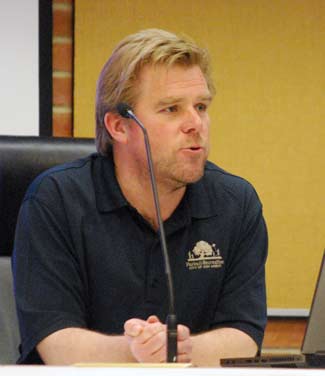
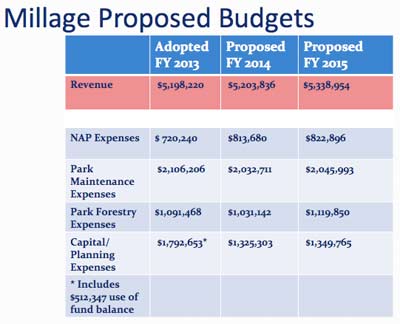

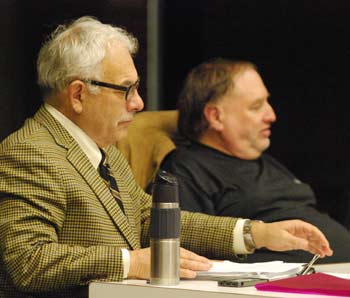

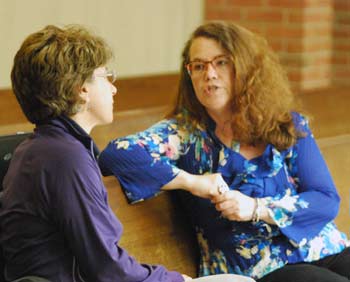
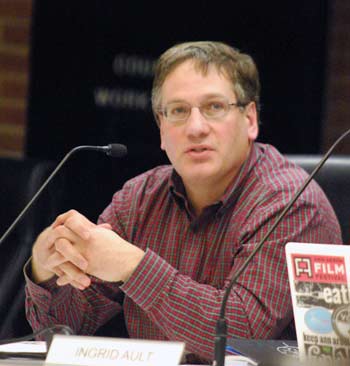
Thanks again to the Chronicle for excellent reporting on local government. One of the most important longterm decisions currently facing the Parks Advisory Commission (PAC) is its recommendation to City Council about downtown parks.
The article referred to the Library Green’s April 23 presentation at the PAC’s downtown park subcommittee. That presentation occurred in a packed-to-capacity conference room at City Hall. Those who weren’t able to be there in person can see the slide show by going to this scribd posting: [link] or you can see the Library Green’s presentation on youtube: [link]
The Library Green Conservancy hopes that people will use whatever opportunities the PAC offers for public input about open space in downtown Ann Arbor. We can create beautiful, inviting public spaces in downtown Ann Arbor – park, plaza, play area, performance venue…. The possibilities are wide open, but the time for action is limited. If people don’t speak up, these publicly owned downtown sites will be sold to the highest bidder and the chance for a true public open space will be gone.
“And in his manager’s report, Smith informed commissioners of an increase in spray-painted graffiti in the parks……”
Seems like the trick is always figuring out how to keep those whose skills lie in self-advancement, promotion of conflict, aggravation of differences, plain old random or planned trespasses, and the ability to promote their cause, from nudging the social gyroscope against its bearings, sending it off in some unplanned quantum direction that cannot be anticipated by our limited Newtonian understandings……
Who are the graffiti artists, unruly young thugs or protoges of Andy Warhol and promoters of pop art in general? Are they criminals or undiscovered artists whose work should be nurtured and promoted rather than condemned or prosecuted? This is the ongoing quasi-debate among property owners, police, and prosecutors, one one hand, and fine art professors and scholars, and the neo-liberal establishment, on the second hand. Dadaism arose during WWI as a European reaction to rigidly rational and nationalistic sensibilities of that era – and eventually emerged as a movement that spawned other art genres. Graffiti is the expressive art form of the youth counterculture.
Should graffiti have limited First Amendment protection? America has had a love/hate relationship with graffiti for decades. The 1973 Oscar-nominated low-budget silver screen production of George Lucas, “American Graffiti”, thrusted the issue into the vortex of public opinion and elicited the phenomenon into the conscious collective Western psyche.
The progressives of Ann Arbor should focus their energies at discovering the causes of graffiti (perhaps via a blue-ribbon municipal graffiti task force)and channeling the energies of these “artists” into less-destructive pursuits while nurturing their creative abilities.
Well Spoken Mr. Koroi, my son is 16 years old and he does graffti paintings(he uses a canvas) in our backyard. His work amazes me how detailed his potraits are with just using cans of spray paint. We have a urinal infront City hall that cost I beleive over 700k. Im sure the DDA can find an area were the youth can graffiti and air brush there work on canvas,plywood,etc. in a controled invirment.
#1) Unfortunately, it’s too late to reign in this plastic skating rink idea as the DDA has now latched onto IT (as opposed to your well designed plans) as the “people’s alternative/public space” to developing the library lot. Now they will flog this (not fully developed) ice rink idea as the reason why they know better. Opportunity lost.
[link]
“Everything we’ve found is that it’s a horrible experience,” Smith said.
The sad thing is- she’s right. It’s not enough like ice skating and the rinks are usually too small-14 parking spaces- to play hockey (the majority of ice rink use). Making it big enough for hockey would be a pretty serious undertaking and would eat up most of that open space.
Like the way the press always interviews the “Free Mumia” contingent at any large (legitimate) protest- just so they can feel justified in labeling the whole protest “fringe dwellers”- I fear Mr. Haber’s ice rink has given the DDA a fringe to scoff at.. It’s perfect for them.
God bless him for jumping out in front of the DDA runaway train but having to ask the DDA for money (without a fully formed proposal) to get his plan going has left Mr. Haber in a terrible position. Along with all advocates of using that as a public space.
Aaaand I hope I’m wrong because even a plastic ice rink would still be better than a conference center.